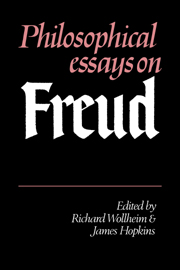Book contents
- Frontmatter
- Contents
- Introduction: philosophy and psychoanalysis
- 1 Conversations on Freud; excerpt from 1932–3 lectures
- 2 Freud, Kepler, and the clinical evidence
- 3 Critical empiricism criticized: the case of Freud
- 4 Freudian commonsense
- 5 Disposition and memory
- 6 On Freud's doctrine of emotions
- 7 The id and the thinking process
- 8 The bodily ego
- 9 Norms and the normal
- 10 On the generation and classification of defence mechanisms
- 11 Models of repression
- 12 Mauvaise foi and the unconscious
- 13 Self-deception and the ‘splitting of the ego’
- 14 Freud's anthropomorphism
- 15 Freud's anatomies of the self
- 16 Motivated irrationality, Freudian theory and cognitive dissonance
- 17 Paradoxes of irrationality
- Works of Freud cited
- Select bibliography
15 - Freud's anatomies of the self
Published online by Cambridge University Press: 01 October 2009
- Frontmatter
- Contents
- Introduction: philosophy and psychoanalysis
- 1 Conversations on Freud; excerpt from 1932–3 lectures
- 2 Freud, Kepler, and the clinical evidence
- 3 Critical empiricism criticized: the case of Freud
- 4 Freudian commonsense
- 5 Disposition and memory
- 6 On Freud's doctrine of emotions
- 7 The id and the thinking process
- 8 The bodily ego
- 9 Norms and the normal
- 10 On the generation and classification of defence mechanisms
- 11 Models of repression
- 12 Mauvaise foi and the unconscious
- 13 Self-deception and the ‘splitting of the ego’
- 14 Freud's anthropomorphism
- 15 Freud's anatomies of the self
- 16 Motivated irrationality, Freudian theory and cognitive dissonance
- 17 Paradoxes of irrationality
- Works of Freud cited
- Select bibliography
Summary
The philosophical knot If you study clinically the sorts of behaviour Freud dealt with, you may justifiably feel tempted to say that they manifest conflict of the individual with himself or herself. You might regard this self-conflict as a clash between forces within the person. And you might wonder, as Freud did: what items contend inside of us? What forms do their struggles take? With great originality and boldness, Freud put forth quite heterogenous theories of the mind's components, and of how their operations result in various types of normal as well as disturbed behaviour. I find many of his speculations altogether spellbinding. Yet despite my unqualified enthusiasm, I fear that none of these ingenious and suggestive partitioning explanations will turn out to be both illuminating and coherent. I plan to illustrate why it was nevertheless reasonable for him to propose such ‘dynamic’ accounts of human activity and affliction. I hope it will be instructive to see which features of behaviour threw Freud into conceptual confusion. These few deep muddles cannot possibly discredit Freud's innovative work. Our appreciation of the difficulties he seems to have encountered should advance our understanding, in philosophy of mind and action, of the person and his reflexive acts.
I realize that the doctrinal thickets I want to rummage in have been staked out by a legion of Freud experts. But I think most of the sceptical commentators have not argued their case in detail.
- Type
- Chapter
- Information
- Philosophical Essays on Freud , pp. 241 - 263Publisher: Cambridge University PressPrint publication year: 1982
- 4
- Cited by



